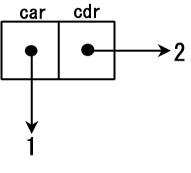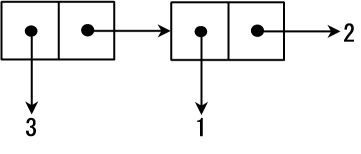 HOME
HOME 2. Using Scheme as a Calculator
2. Using Scheme as a Calculator Yet Another Scheme Tutorial
Yet Another Scheme Tutorial 4. Defining Functions
4. Defining Functions Post Messages
Post Messages
 HOME HOME |
 2. Using Scheme as a Calculator
2. Using Scheme as a Calculator |
 Yet Another Scheme Tutorial Yet Another Scheme Tutorial |
 4. Defining Functions 4. Defining Functions |
 Post Messages Post Messages |
In this chapter, I will explain basic list operators, such as cons, car, cdr, list and quote.
Give (cons 1 2) to the front end.
(cons 1 2)
;Value 11: (1 . 2)
It responds (1 . 2).
Function cons allocates a memory space for two addresses as shown in Figure 1.
and stores the address to 1 in one part and to 2 in the other part.
The part storing the address to 1 is called car part and
that storing the address to 2 is called cdr part.
Car and cdr are abbreviations of Contents of the Address part of the Register
and Contents of the Decrement part of the Register. These are originated from the names of
memory spaces of the hardware on which Lisp was first implemented.
These names also indicate that the reality of the cons cell is a memory space.
The name cons is an abbreviation of a English term 'construction' for your information.

Cons cells can be beaded.
(cons 3 (cons 1 2))
;Value 15: (3 1 . 2)
(3 1 . 2) is a convenient notation for (3 . (1 . 2)).
The memory space of this situation is shown in Figure 2.

Cons cells can store different kinds of data and can be nested.
(cons #\a (cons 3 "hello")) ;Value 17: (#\a 3 . "hello") (cons (cons 0 1) (cons 2 3)) ;Value 23: ((0 . 1) 2 . 3)This is due to that Scheme manipulates all the data by their addresses. (#\c represents a character c. For example, #\a represents a character a.)

Actuary, list can be defined recursively like as follows:
For instance, while (+ 2 3) is evaluated to be 5, (quote (+ 2 3)) gives a list
(+ 2 3) itself to the program. As quote is frequently used,
it is abbreviated as '.
For example:
(car '(1 2 3 4)) ;Value: 1 (cdr '(1 2 3 4)) ;Value 18: (2 3 4)
(list) ;Value: () (list 1) ;Value 24: (1) (list '(1 2) '(3 4)) ;Value 25: ((1 2) (3 4)) (list 0) ;Value 26: (0) (list 1 2) ;Value 27: (1 2)
;1 (cons "hi" "everybody") ;Value 32: ("hi" . "everybody") ;2 (cons 0 '()) ;Value 33: (0) ;3 (cons 1 (cons 10 100)) ;Value 34: (1 10 . 100) ;4 (cons 1 (cons 10 (cons 100 '()))) ;Value 35: (1 10 100) ;5 (cons #\I (cons "saw" (cons 3 (cons "girls" '())))) ;Value 36: (#\I "saw" 3 "girls") ;6 (cons "Sum of" (cons (cons 1 (cons 2 (cons 3 (cons 4 '())))) (cons "is" (cons 10 '())))) ;Value 37: ("Sum of" (1 2 3 4) "is" 10)
;1 (car '(0)) ;Value: 0 ;2 (cdr '(0)) ;Value: () ;3 (car '((1 2 3) (4 5 6))) ;Value 28: (1 2 3) ;4 (cdr '(1 2 3 . 4)) ;Value 29: (2 3 . 4) ;5 (cdr (cons 3 (cons 2 (cons 1 '())))) ;Value 31: (2 1)
 HOME HOME |
 2. Using Scheme as a Calculator
2. Using Scheme as a Calculator |
 Yet Another Scheme Tutorial Yet Another Scheme Tutorial |
 4. Defining Functions 4. Defining Functions |
 Post Messages Post Messages |